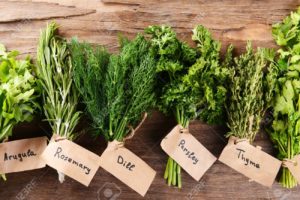
Fresh herbs can jazz up your cooking all year round, but the height of summer’s bounty— that would be right now!—is the perfect time to take advantage of the many flavorful herbs that are literally bursting from the ground.
Why Cook with Fresh Herbs?
Adding fresh herbs to your recipe is sure to result in a dish that’s absolutely brimming with flavor and complexity. Dried herbs not only lose flavor over time (dried herbs only stay fresh for about 1-3 years), but the heat used in the drying process may cause some of the herbs’ nutrients to be lost.
Fresh herbs are healthy!
They add tons of flavor without lots of extra calories, saturated fat, or sodium. (Try topping that baked potato with fresh parsley and chives instead of butter and salt—delicious AND nutritious!)
Herbs have also been used throughout history for medicinal purposes. Lemon verbena, for example, has traditionally be used for digestive orders, while tarragon (also known as dragon’s wort, which is a GREAT name) has seen a variety of uses, from treating bad breath and body odor (yes, really) to helping with insomnia.
How to Store Your Herbs
You just got home, fully stocked up on bunches of herbs from the grocery store or farmer’s market. Now what? Think of your herbs as tiny bouquets of flowers. Store them, stems down, in a few inches of water in the refrigerator. Then use a plastic produce bag as a little tent to help keep them hydrated. This will help your herbs last up to two weeks (if you haven’t eaten them by then!).
Another storage suggestion is to wrap herbs in a damp paper towel and store them in a ziplock bag along with the rest of the produce in your fridge. The goal is to keep your herbs hydrated and cool so they’ll be crisp and fresh for as long as possible. Try either (or both) storage methods and see what’s most convenient for you.
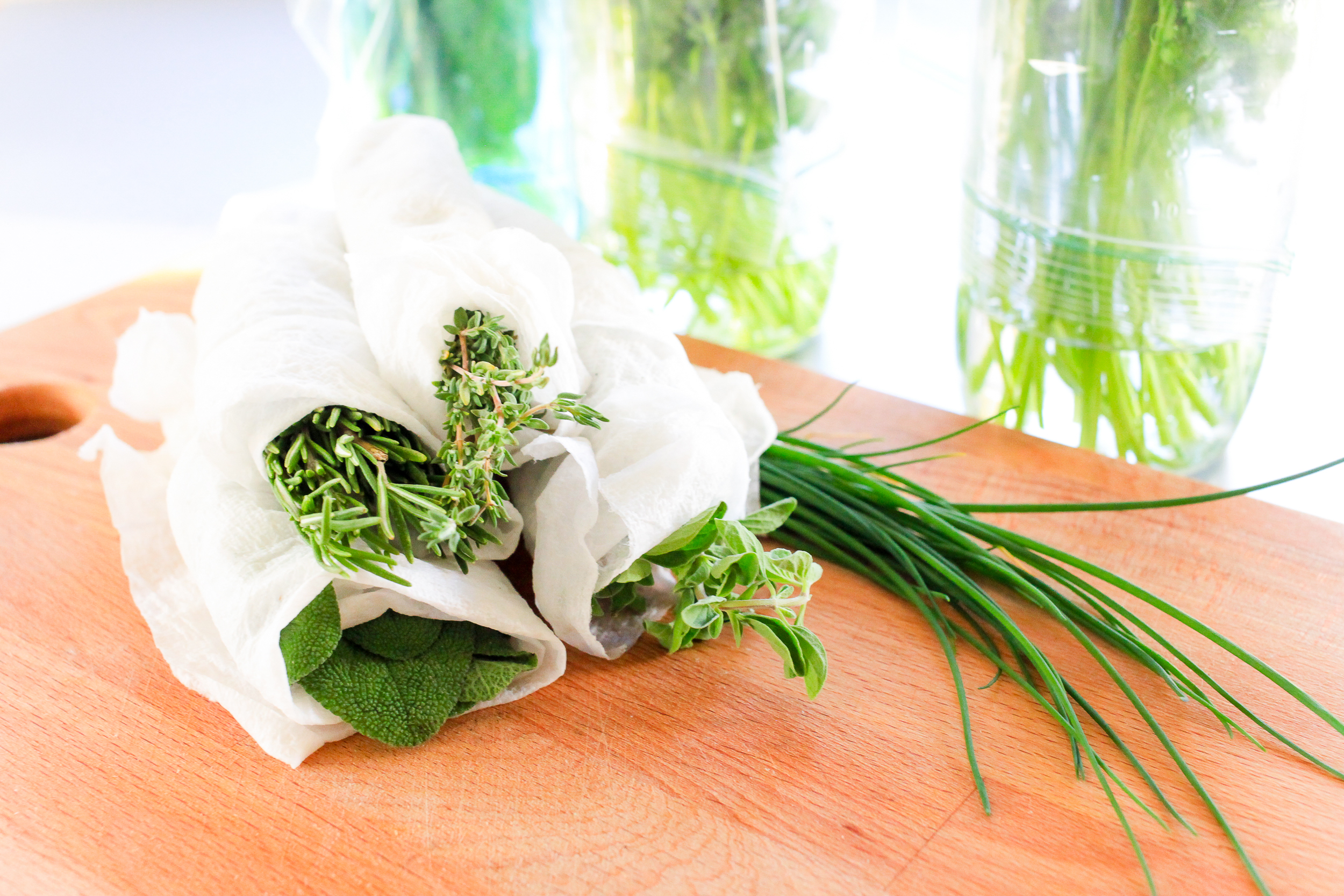
(Note: These storage methods don’t apply to basil. Basil is happiest at around 55 degrees, which is warmer than your fridge. Store cut basil on the coolest section of your kitchen counter, away from the summer sun.)
If you still have some herbs left and you’re worried that you won’t use them before they go by, chop them up and freeze them with water in an ice cube tray. Store the frozen cubes in a plastic bag so you’ll have instant access to small portions of fresh herbs to add to recipes as needed.
Time to Use Those Herbs!
Fine Cooking has a great how-to on prepping and chopping herbs. Make sure the knife you use is nice and sharp. A dull knife will bruise the herbs rather than cutting through them cleanly, which can cause a lot of the herbs’ flavor to be lost on the cutting board rather than added to your meal.
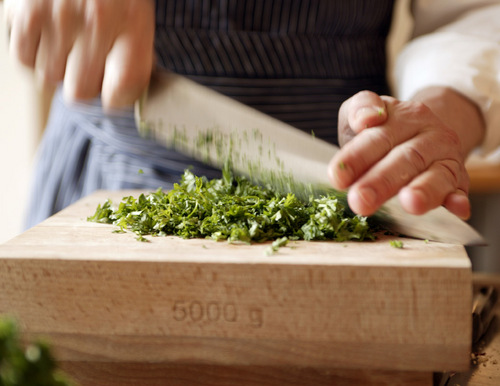
And fresh herbs aren’t just for your food—try adding them to your drinks this summer, too! Add a handle of mint or basil to your water bottle for a little extra flavor as you keep hydrated. And check out this list of herb-infused cocktails—Lemon Verbena and Orange Blossom Fizz, anyone?!
Don’t be intimidated by thoughts of what herb “goes” with a certain food. Experiment! Add some tarragon to vinegar and use it on your salad tonight. Toss a handle of fresh basil into that jarred pasta sauce. Sprinkle some dill atop a bowl of cottage cheese. Throw some chives and oregano into your scrambled eggs tomorrow morning. The possibilities are endless and your palate will thank you.
Are you using a recipe that calls for dried herbs? If you want to replace the dried herbs with fresh ones, be sure to double the amount the recipe calls for. The drying process tends to concentrate the flavor of herbs, so if a recipe calls for half a teaspoon of dried oregano, replace it with a full teaspoon of fresh oregano.
Don’t Throw Out Those Stems!
You can get more use out of your herbs than just the leaves. Cilantro stems are nearly as flavorful as the leaves.
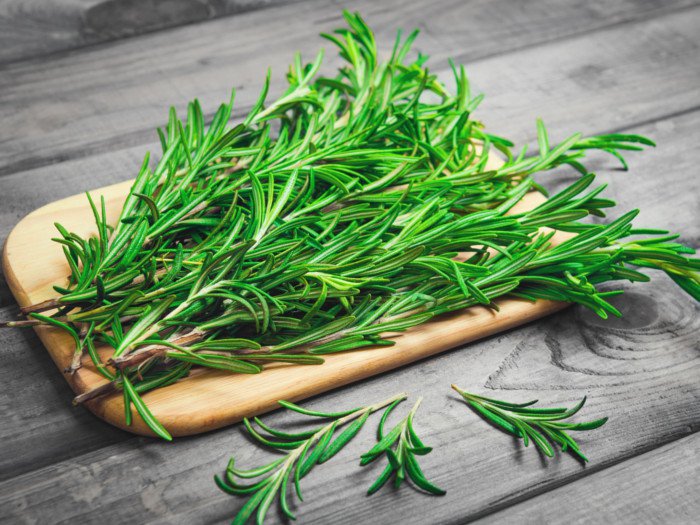
You can chop the stems up for your guacamole right along with the leaves, or you can use the stems for a completely different recipe, like this Cilantro-Ginger Mojo sauce, which only takes five minutes to make and is perfect served atop grilled meat.
The very bottoms of the cilantro stems may be a little more fibrous or soggy than is ideal, however, so we suggest removing and composting the bottom inch of the stems, leaving you with just the crispiest, most tender parts of the stems to work with.
Rosemary has a tough, woody stem, which means you probably won’t want to eat the stem. That doesn’t mean you can’t cook with it, though! Branches of rosemary can be used as skewers, and the oils from the rosemary stem will infuse the food. Need a suggestion?
Try making antipasto skewers (we like a cube of mozzarella, a little salami, an artichoke heart, a cherry tomato, and a nice briny olive to cap it off). For these, we would suggest leaving just an inch of two of the leaves at the top (this isn’t totally necessary if you have another use for those leaves, but it does look pretty!) to make it easier to get more delicate items like the artichoke hearts onto the stem. If you want try a classic, like grilled lamb on rosemary skewers, feel free to leave all those leaves right on the branch!
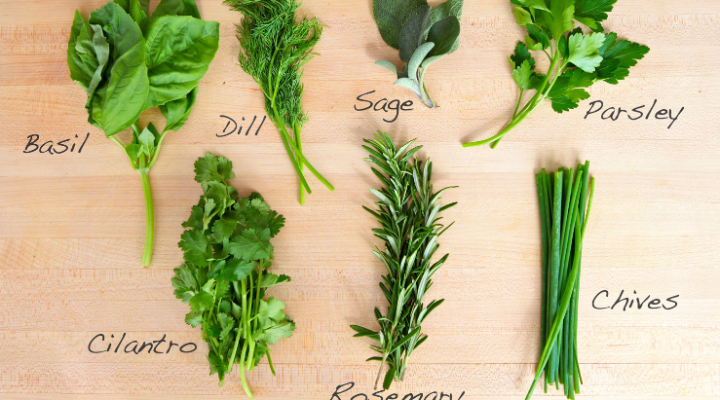
Another idea is to add a big stem of rosemary (or any herb) to your soup or stock as it simmers, which can impart a subtle complexity to the dish. And it won’t require any additional blending or pureeing later since you can just remove and discard the whole stem after you’re done cooking.
If you’ve never cooked with fresh herbs before, what are you waiting for?! And if you cook with fresh herbs but generally stick to the usual suspects (parsley, cilantro, thyme), take our Herb Challenge (we just made that up right now) and try to experiment with a new-to-you herb this summer. And be sure to let us know how it goes in the comments!
Happy cooking!







